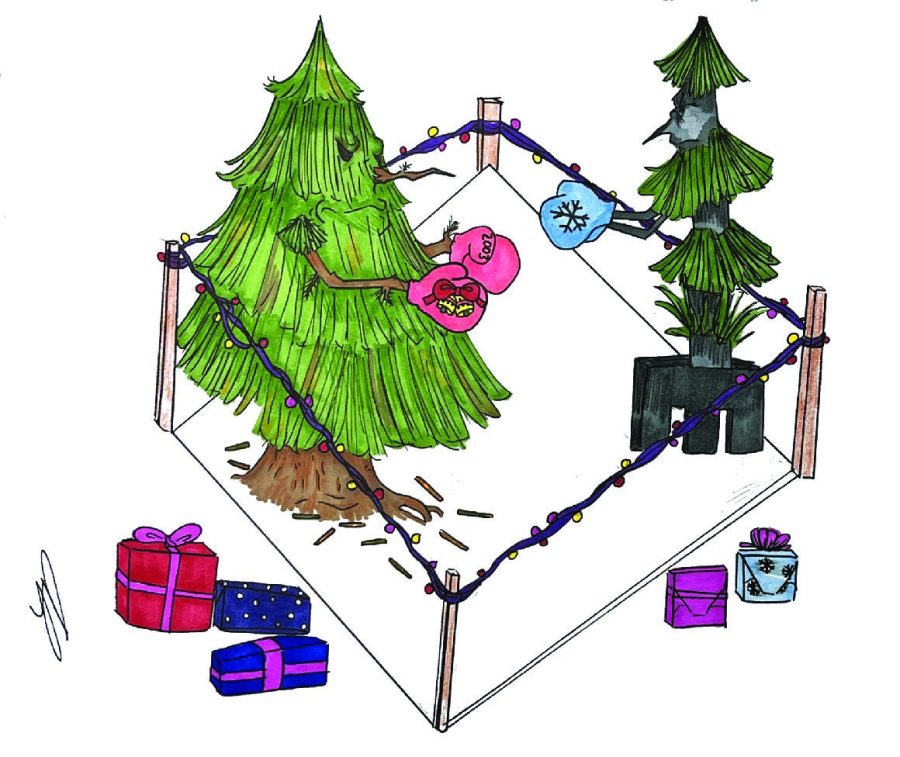Pro: Real Christmas trees are happier, healthier
Because Christmas trees are organic farmed plants, their inherent benefits range from helping their owners’ health during the holiday season to being a reliable crop during the end of the year.
Senses are a big part of the holiday season.
Festive sights, smells and sounds are really what makes Christmas feel like Christmas, so the fresh pine scent of a real Christmas tree definitely improves the holiday atmosphere.
A 2018 study published in Behavioral Sciences also found that having live houseplants helps improve mental health by reducing stress.
Given that the holiday season is a stressful time for many, having something that not only helps tone down that chaos, but also reflects the more positive aspects of the season, is both comforting and pleasant.
Caring for houseplants can help people destress and provides more overall comfort to the plant owners.
Believe it or not, maintaining a live Christmas tree can have a similar effect, which a plastic tree cannot replicate.
Real Christmas trees are also highly beneficial to the environment, since they are used to help protect ecosystems.
After the holiday season ends, many beaches and coastal towns such as East Lyme in Connecticut and Fort Macon State Park in North Carolina will use discarded Christmas trees as barriers to protect sand dunes from erosion.
According to Connecticut Sea Grant, an organization dedicated to preserving marine environments and keeping resources sustainable, the discarded trees are used to help build up sand dunes and protect coastlines from flooding.
Some zoos, such as the Oakland Zoo in Oakland, California and the Claws ‘N’ Paws Wild Animal Park in Lake Ariel, Pennsylvania also use the discarded trees as enrichment for their animals as food or playthings, which in turn keeps them healthier as well.
Real trees are also biodegradable, since they are organic.
Once the holiday season ends, they can be donated or broken down for mulch without harming the environment.
On the other hand, most artificial trees are made of plastic, an inorganic material, and thus are not biodegradable.
According to an article by Recycle Track Systems, artificial trees can take upwards of 500 years to decompose.
Christmas tree farms are also able to help filter the air and water in the local area as a natural forest would, which can prove to be very valuable in a location with less forests and other wildlife.
Living Christmas trees also help combat deforestation, since the trees are taken from farms and not pine forests.
Purchasing living trees can actually help cut deforestation and carbon emission rates, since the farms leave the forests alone.
On the other hand, production of fake trees, like most man-made products, constantly produces pollution.
In terms of sustainability, it’s better to purchase a new, living tree every year than to purchase a fake tree.
Production isn’t going to stop on either side, but fake tree production hurts the environment, while growing live trees can help to heal it.
Christmas tree farms have their own benefits, too.
In addition to being better for the environment overall, Christmas tree farms can be a very valuable source of income for farmers, especially local ones.
Since evergreen trees are so resilient when it comes to growing conditions, being able to grow in soil unfit for other crops, and since Christmas trees are always in high demand during the holiday season, farmers that establish their tree farms can find it to be a very sustainable source of income.
Real Christmas trees are happier and healthier for both individuals and the world in general.
Between Christmas trees and their plastic counterparts, live trees are ultimately the best.






